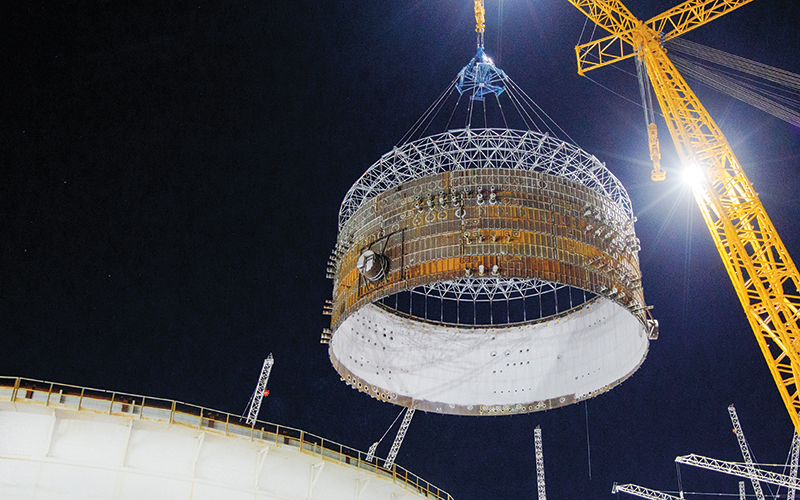Delivering net zero
Advanced nuclear energy must play a role if we are serious about decarbonising society, says Tim Yeo at the New Nuclear Watch Institute

The need to increase both the scale and speed of humanity’s response to climate change becomes more urgent every day. Total decarbonisation of all our societies is now widely accepted as the goal. Agreement on how to achieve it is more elusive.
The fall in global emissions forecast by the International Energy Agency (IEA) for 2020, the year when the COVID-19 pandemic has wreaked economic havoc in almost every country and destroyed millions of jobs, is only slightly higher than the reduction now needed every year until 2030 to prevent average surface temperatures from rising by more than 1.5˚C.
Embracing system flexibility
Driven by the imperative of climate action and supported by the development of new low-carbon technologies, both the appearance and function of power systems across the world have been transformed in recent years.
This trend is likely to accelerate as the use of fossil fuels to generate power continues to be phased out and a wider range of sectors and processes are decarbonised through electrification. This change will require a far greater level of integration between sectors, such as power and transport, than is currently the case.
As a result, power systems will have to become much more flexible in terms of both their ability to respond to an external stimulus, such as temporary fluctuations in demand, as well as the services and products that they are able to provide. Only in this way can the security, sustainability, and affordability of our energy avoid being compromised in the years ahead.
The value of nuclear
In this context the system flexibility that nuclear energy can deliver represents a valuable way of facilitating, and indeed easing, the much-needed transition to a decarbonised world.
Until now the flexible operation of existing nuclear technologies has been limited to the moderation of generation output in response to the needs of the grid. This has allowed for a greater penetration of intermittent renewables and for the maintenance of system stability.
GW-scale reactors of the type already installed across the world can also provide other forms of flexibility. Hitherto these have not been harnessed to full effect but they offer significant decarbonisation potential.
Nuclear plants, in addition to generating electricity, are sources of clean thermal energy and chemical production. Two notable applications are the use of thermal energy to provide district heating and the use of electricity to produce low-carbon hydrogen via electrolysis. Both these applications represent low-carbon alternatives to the main ways currently used to produce heat and hydrogen.
Advanced nuclear technologies offer an even greater range of flexibilities than the GW-scale reactors in operation today. Their smaller size is better suited to replacing fossil fuel-powered plants and allows them to be sited in smaller grids and isolated areas. Their modular design and factory-built parts should cut installation times and their lower upfront capital costs makes them more affordable.
Moreover, a number of advanced nuclear designs are capable of producing greater thermal energy than those based on water-cooled reactor technology. This expands the range of possible thermal applications to include the high-temperature production of hydrogen, a more efficient source of low-carbon hydrogen than low-temperature electrolysis, and major industrial processes at petrochemical plants, refineries and others.
The UK government has rightly acknowledged the significant potential of advanced nuclear technologies. It has included them in its recent ‘Ten Point Plan for a Green Industrial Revolution’ and new Energy White Paper, and earmarked £385m for an Advanced Nuclear Fund.
The nuclear industry should start lobbying for nuclear energy to be endorsed by COP26 as an essential part of the world’s answer to climate change
Closing the net zero intention-action gap
Many countries who signed the 2015 Paris Accord failed to reach the emission reduction targets they set themselves. As a result, close attention will now be paid to how the more ambitious goals for net zero by mid-century can actually be achieved.
There is a yawning gap between the lofty intentions expressed by politicians and delivery of the actions that are needed. Nuclear energy can help close this gap as long as it is allowed to do so by its irrational and sometimes entrenched opponents, some of whom masquerade as environmentalists. Three steps are needed.
First, in the immediate future, as the IEA has pointed out, the fastest and cheapest way to cut emissions at a stroke is to extend the life of existing nuclear plants wherever safe to do so. Shutting safely operating nuclear plants prematurely makes net zero harder to reach.
Second, the construction of new large-scale plants must be accelerated and expanded substantially. If done promptly, this will prevent the decline in worldwide nuclear capacity that would otherwise result from the closure of the oldest plants by the end of this decade.
Third, the development of advanced small reactors must be encouraged by governments around the world. In this way they will be able to comprise a meaningful proportion of global low-carbon electricity production in the 2030s.

Call for action
The relative success of COP21 in Paris in 2015 owed much to the careful preparatory work of the French hosts, led by former Prime Minister Laurent Fabius. The nuclear industry should take a leaf from his book and start lobbying for nuclear energy to be endorsed by COP26 as an essential part of the world’s answer to climate change. In that way, good intentions will translate seamlessly into effective action.
By Tim Yeo, Chair, New Nuclear Watch Institute






Follow us
Advertise
Free e-Newsletter